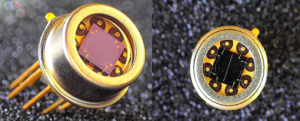Marktech Optoelectronics Announces New InGaAs Quad and Array Photodiodes for Laser Alignment and Position Sensing
Marktech Optoelectronics today announced their offering of new InGaAs quadrant and array photodiodes for laser alignment and position sensing applications.
LATHAM, NY, US, September 27, 2022 /EINPresswire.com/ -- Marktech Optoelectronics, Inc. (www.marktechopto.com)(Marktech), a privately-held leading designer and manufacturer of standard and custom optoelectronics, including UV, visible, near-infrared (NIR), and short-wavelength infrared (SWIR) emitters, detectors, InP epi wafers, and other compound semiconductors, today announced their offering of cutting-edge InGaAs quadrant and array photodiodes for laser alignment and position sensing applications.
InGaAs Quadrant Photodiode Position Sensing Detectors
“Quads” or quadrant photodiodes (QPDs) are segmented photodiode position sensing detectors (PSD, AKA position sensing diodes) with four planar diffused photodiode elements, which are monolithic or on the same silicon or InGaAs chip. Marktech Optoelectronics quad photodiodes have low dark current, high resolution or precision, high accuracy, high response with low noise (high S/N ratio), wide spectral ranges, good frequency bandwidth, excellent dynamic range, minimal element spacing, low operating voltages, high shunt resistance, and large active areas.
Our InGaAs quadrant photodiodes and photodiode arrays have a wavelength sensitivity range from 600nm to 2600nm (600nm to 1700nm for our 1.7µm InGaAs photodiodes and 800nnm to 2600nm for our 2.6 µm InGaAs photodiodes). Our silicon quadrant photodiodes and photodiode arrays have a wavelength sensitivity range from 250nm to 1100nm.
Quads can be used in auto-collimators for laser alignment, optical trackers, scanning probe microscopes, stage positioners, surface profilometers, mask aligners, beam centering systems, space sun sensors, ellipsometers, optical tweezers, tilt sensors, high accuracy displacement sensors, and other ultra-precision positioning applications. The fast response and wide operational bandwidth of QPDs have made these positioning devices dominant in the atomic force microscope (AFM) industry
InGaAs Photodiode Arrays
Both bi-cell and quadrant photodiodes are photodiode arrays (PDAs) with two (1X2) and four (2X2) elements, respectively. Bi and quad PDs are suitable for alignment or position sensing over a small beam displacement or position range. For laser or light beam position sensing over a more extensive range, longer, multi-element photodiode arrays are necessary. Marktech’s detector experts have designed and manufactured photodiode arrays with 2, 4, 16, 20, 32, 64, and more elements. InGaAs linear arrays are employed in pulsed laser or direct time of flight (TOF), phase shift or indirect time of flight (TOF), and triangulation position sensors.
Custom InGaAs Photodiodes and Packaging
Marktech Optoelectronics has vertically integrated capabilities to custom design and fabricate InGaAs photodiode array devices on wafers and then dice and package these photodiode chips with any required amplifiers, filters, and components for specific applications. This vertical integration allows Marktech to precisely control the performance and quality of the quadrant and array photodiodes designed for our customers.
Consult with Us Today About Your Design Project
Using Marktech Optoelectronics advanced InGaAs photodetectors in new products under development will likely lead to breakthrough designs in many analytical instruments, medical diagnostics, and industrial sensing applications.
Additional details and the full version of this press release can be found here:
https://marktechopto.com/marktech-announces-new-ingaas-quad-and-array-photodiodes-for-laser-alignment-and-position-sensing/
Gary Kardys
Marktech Optoelectronics
+1 518-956-2980
email us here
Legal Disclaimer:
EIN Presswire provides this news content "as is" without warranty of any kind. We do not accept any responsibility or liability for the accuracy, content, images, videos, licenses, completeness, legality, or reliability of the information contained in this article. If you have any complaints or copyright issues related to this article, kindly contact the author above.


